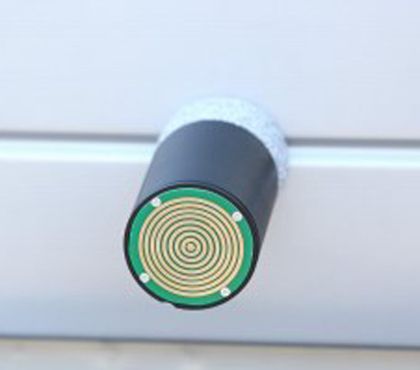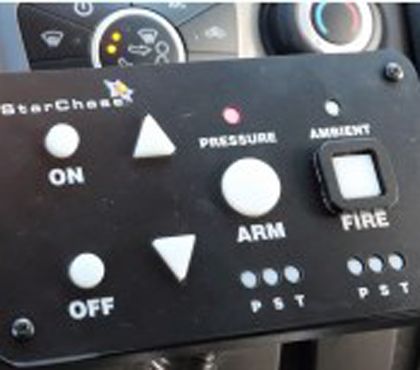By Lisa Kashinsky
The Eagle-Tribune
METHUEN, Mass. — It was a police pursuit that started in Epping, New Hampshire, and ended on a dead-end street in Methuen with a crash that police Chief Joseph Solomon said could have been avoided with new technology.
In May 2015, police chased a vehicle on Hampstead and Howe streets in Methuen at high speeds before it turned onto Kensington Avenue. Faced with a dead-end, the driver tried to turn the vehicle around and a police cruiser rammed its right side.
That high-speed chase and crash might have been avoided, however, had the police department had StarChase, Solomon said.
With StarChase, officers can tag a fleeing car with a GPS tracker contained in a dart and monitor the vehicle from a distance without losing track of it.

A Starchase dart on the back of a fleeing vehicle. (Photo/Starchase)
“I’ve seen pursuits over my career where people have been seriously injured,’' Solomon said. “Vehicles have lost control and crashed into other cars. I’ve seen pursuits where people in the stolen car were killed during the pursuit when they lost control and crashed.
“As a leader you have to say, ‘What can I do to help steer the direction of law enforcement to better protect citizens and police?’” he said.
The solution was StarChase — a technology that can help reduce risk in a pursuit by allowing officers to use safer speeds and better manage setting up road blocks and other tools to catch a fleeing vehicle.
Methuen is the first police department in New England to use the tracking technology, developed by a company based in Virginia Beach, Virginia.
Solomon discovered StarChase while doing internet research into ways to reduce police pursuits.
The department previously used “stop sticks” to slow cars by deflating their tires, but Solomon was looking for something even safer.
He saw a video for the StarChase darts and was intrigued. He got in touch with the company for more information and a demonstration.
StarChase works by having a launcher attached to a police cruiser. The equipment includes two darts and a laser that helps target the fleeing vehicle. The darts can be launched from the police cruiser either by the officer at the controls inside the cruiser or from outside the cruiser, if an officer is approaching a vehicle on foot at a traffic stop, for instance.

The control panel for the GPS darts. (Photo/Starchase)
Once a vehicle is tagged with a dart, officers can track the location and movements of the vehicle through a web-based mapping portal, with updates delivered every three to five seconds, according to the StarChase website.
“One of the things I like about it is that it deescalates the pursuit right when it starts,” Solomon said. “Bang – I’ve tagged the vehicle and I’m backing off. I activate the GPS locator, pull up the screen and just start dispatching people. I think it’s very important that it’s an immediate deescalation.”
Being able to track a vehicle using GPS helps in several ways. Officers involved in the pursuit can drive at safer speeds – for instance, 80 mph instead of 100 or 120, the chief said – and can dispatch other officers farther along the fleeing vehicle’s path to set up something like a rolling road block.
“In most pursuits when (the suspects) believe the police are gone, they’ll pull into traffic and slow down and drive normally or they ditch the vehicle,” Solomon said.
Even if a suspect leaves a vehicle behind, police will know the location of the vehicle and can respond to the area with K-9 units for a foot search.
“I’d much rather have my dog chasing someone than us driving at 100 mph,” the chief said.
Reducing the risks of the chase could also help those involved psychologically, keeping adrenaline more at bay to help “reduce the level of force used at the end with the arrest,” Solomon said.
Solomon said StarChase has an 80-to-90 percent success rate. All of the darts fired during recent demonstrations at the police station stuck to the target vehicle.
“So we fire both darts and we miss. What do we lose? Nothing. If we tag you, then we back off,” Solomon said.
The department has outfitted five vehicles with the dart launchers – two that will be stationed in the east side of the city, two for the west side and one in the central area, for full coverage – and Solomon hopes to expand that in the future to other units in his department.
Methuen police demonstrated that technology, along with the department’s body cameras, at the Verizon Innovation Center in Waltham recently and plan to hold a demonstration for local police departments in December.
“Not too often do you get something that helps save people’s lives in a real-life situation,” Solomon said.

